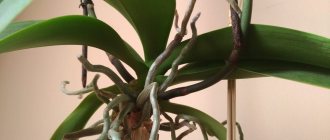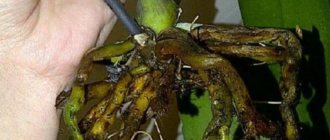Flower growers who are passionate about growing orchids know how capricious the plant can be. Often, outwardly, the flower does not look sick, but still dies. The reason lies in diseases of the plant roots. Therefore, it is important to try to revive an orchid whose root system has only rotted. Moreover, the plant simply needs help, since due to careless care, different parts of the orchid disappear.
Step-by-step instructions: how to carry out the procedure correctly?
It is advisable to prune dead roots when your flower has already bloomed and is at rest.
But there are times when replanting a plant and pruning putrefactive formations is urgently necessary. Then you have to choose between blooming and saving the flower. So, you've decided to trim. If the orchid is in bloom, then first of all you need to remove the peduncle. Alas! Beautiful flowers will have to be sacrificed.
This must be done so that the flower’s forces are switched to the creation and growth of a new healthy root system.
Preparing tools
To remove infected and dry roots, you need to prepare the following tools and devices:
- Knife (scissors, pruning shears).
They must be well sharpened so that unnecessary roots are removed in one motion. It is not advisable to use nail scissors for this procedure. They are too small and can cause irreparable harm to the plant. - Antiseptic for disinfecting instruments. In the absence of such, burning the instrument with fire is allowed.
- Medical rubber gloves. They are necessary not only to protect your hands, but also to prevent substances on the skin of your hands that are unnecessary for the plant from getting onto the cut plant.
- Powdered activated carbon (if unavailable, can be replaced with charcoal). It will protect fresh cuts from drying out and infections.
- Oilcloth and a new pot (if the old pot is the right size for your orchid, you can use it after treating it with an antiseptic).
Search for roots
First you need to carefully remove the orchid from the pot, being careful not to damage the root system. This is easiest to do when the soil is dry. Then shake off the roots from the soil
If that doesn’t work, carefully untangle the roots with your hands and remove excess substrate. Let's move on to inspecting the root system. Rotten roots can be seen immediately, they acquire a peculiar brownish color and are distinguished by excessive moisture. We check dried roots with water to see if they are capable of further vital activity
If not, feel free to classify them as circumcised.
So, we have identified the roots that need to be removed.
Process
- Cover the table with oilcloth.
- Wear rubber gloves.
- Treat instruments with an antiseptic.
- Cut off damaged roots with a knife:
- If the rot is located only in the lower part of the root, only the affected area needs to be cut off.
- If the root has rotted at the base of the flower, it is cut off completely.
- Treat the sections with an antiseptic.
How to treat the damaged area?
A cut for a plant is like a wound for a person. Through it, the flower can become infected. Therefore, processing the cut is a mandatory procedure when cutting roots. There are several ways to process slices:
- Crush the activated carbon tablet into powder and sprinkle on the cut area.
- You can do the same with charcoal.
- A good anti-rot agent is sphagnum moss. It must be crushed and applied to the cut site.
- Manganese solution. Process the cut area.
- Zelenka. Process the cut area.
- Ground cinnamon is an excellent fungicidal agent for treating orchid cuttings.
Do not treat cut areas on orchid roots with vodka or alcohol. They can dry out healthy roots.
After the cut areas of the orchid have been treated, a vitamin compress can be applied to the exotic roots. To do this, dilute 1 ampoule of vitamins B12, B1, B6 in 1 liter of water. Place the roots of the flower in this solution and keep them there for 10-15 minutes.
In what cases is it used?
After flowering, as soon as the orchid begins its dormant period. During an emergency transplant, if the donated flower has roots sticking out of the pot. If the plant is healthy, but does not bloom for a long time, then partial pruning is used - not only the old peduncle is removed, but also the lower leaves of the orchid.
Emergency pruning is used in the following cases:
- the leaves began to turn yellow;
- the plant withers;
- leaf blades are severely damaged or sunburned;
- parasites appeared;
- rot appeared on the roots
Reason 2: inappropriate pot volume
If there is no replanting for a long time, another problem may arise - the orchid simply outgrows its pot. Moreover, the better conditions the plants are kept in, the faster this process occurs.
Determining that the roots have become too crowded in the pot is quite simple:
- through the walls of the container it is noticeable that the roots have completely mastered the volume and are interfering with each other;
- individual roots began to grow through the drainage holes;
- the plant appears “lifted” because the growing root system pushes it out of the pot.
An orchid that has outgrown its pot is easy to recognize - it falls on its side, and if the container is too light, it may even turn over.
Removal before, during and after flowering - what's the difference?
During flowering, the orchid is weakened, it spends a lot of energy creating beauty. And if pruning is done at this time, the plant will receive additional stress, which will not be in vain.
If we consider the time after flowering (how to properly prune an orchid after flowering?), then the orchid will have more strength to recover if the pruning is done correctly and on time. But it’s worth repeating - this does not apply to a diseased plant; it needs to be pruned in any case to save it.
Why did the orchid roots come out of the pot?
It is also worth taking into account the fact that the procedure for supplying nutrients and moisture to an orchid that is located at home differs from that in natural conditions. Under natural conditions, an orchid receives nutrients only through the root air system
Under natural conditions, an orchid receives nutrients only through the root air system.
It grows where there is practically no soil, and is attached by branches to trees and large plants.
This form of existence is called an epiphyte.
An orchid that is placed in soil mainly receives nutrients and moisture from it.
But still it releases some of the roots to the surface and this is normal.
You can determine how a plant feels by the condition of the roots, because any deviation from the norm is reflected in the roots.
They begin to rot, change color, or dry out.
If the roots are greyish-green in color and do not look healthy (when in good condition they are fleshy and elastic), this means that the plant is under stress.
Healthy shoots are light green.
Pay attention to the density of the roots; if they grow too densely, transplant the flower into a larger pot. Use a special soil substrate for orchids.
Use a special soil substrate for orchids.
The orchid will receive nutrients from this substrate and will not have much need to produce a lot of aerial roots.
What to do?
Look at the condition of the roots, if they are firm and white, it means they are healthy and you don't need to do anything.
What you definitely cannot do is remove aerial roots if they are healthy.
If the roots are dry and dead, they can be cut off, but this must be done very carefully, the tool must be disinfected.
You cannot cut off the healthy part of the root; some kind of virus can get into the open wound.
How to reduce aerial roots?
The appearance of a large number of roots can be influenced by the conditions in which the orchid is kept.
Lack of space
If an orchid becomes crowded in a pot, it will move its roots outward, in search of a new place.
In this case, you need to transplant the plant into a larger pot.
To allow the roots to receive more light, plant them in a transparent pot.
Overwatering
If a flower is flooded with water, its roots will begin to rot and aerial roots will begin to form, just to survive.
Lack of moisture
If the roots do not have enough water, they will begin to grow outward, because with the help of the roots the orchid receives moisture from the environment.
There may be a lack of moisture not only due to lack of watering, but also due to dry air.
Soil density
Dense soil is not suitable for orchids; it is difficult for roots to develop in it.
Substrate
If the soil is chosen incorrectly, the flower will try to escape from unfavorable conditions.
The substrate should be changed once every 3 years.
Insufficient lighting
Lack of light stops the process of photosynthesis and the roots begin to rot, so the plant is forced to send out the roots to get light.
The orchid has yellow roots, what to do? So, orchids with light roots:
White on the outside, hollow on the inside.
A common mistake made by inexperienced flower growers: they think that if the root is light, then it is alive, but if you cut the root, it turns out that it is dry and empty inside.
Is yellow bad?
Sometimes the roots, deeply immersed in the substrate, acquire a yellow or even brown tint. The reasons for this are that the roots are in the dark, in addition, the color of the roots can be affected by substances that the orchid absorbs from the soil. In this case, the dark color of the roots in no way indicates a deterioration in the health of the flower.
How to determine whether orchid roots are dead or alive?
If the root is hard and elastic, this is a sign of its viability.
And vice versa: even if the root looks quite healthy, but when pressed with a finger or nail it is easily pressed, then most likely this root is already dead.
It happens that a generally healthy root has a necrotic area somewhere in one place. Such a root is no longer useful to the plant, since it is not able to fully nourish it, and can even cause harm: the dead area can become a source of infection for the plant stems. Therefore, when examining the roots, be very careful.
It is a mistake to assume that if the upper, green part of the orchid is normal, then everything is fine with the roots. The pathogenic process in the roots does not occur at lightning speed, and if you identify diseased roots in time, you will have time to save the orchid.
Causes of root death in orchids:
- excessive moisture, poor lighting, too dry soil in the heat - that is, a violation of the agrotechnical conditions for growing orchids;
- fungal or bacterial infection of the plant;
- advanced age of the plant.
What to do if you find dead roots on your orchid?
First of all, correct mistakes in caring for the plant. An orchid can only be revived in conditions that are optimally favorable for it. A new root system can only appear from new shoots, in turn, new shoots can only come from green living buds. Our first task is to find these same kidneys.
Is it possible to remove part of the plant and when is the best time to leave it?
During flowering, it is better not to touch the orchid if its life is not in danger. There are several general signs when you can cut a peduncle from a healthy plant:
- the arrow does not dry out, but no longer blooms, for a long time;
- the arrow faded and dried up immediately;
- babies or new shoots appeared in the axil of the peduncle;
- the arrow suddenly changed its color.
But if the plant gets sick, its leaves begin to turn yellow, the roots change color, parasites appear, then there is no choice - in this case, pruning is carried out both on the flowering plant and on the plant during the dormant period.
Is it possible to trim aerial or underground roots and is it necessary?
The first thing that orchid breeders need to know is that most species of this plant are epiphytes. Therefore, the plant has two types of roots:
- air;
- underground.
If with the underground everything is more or less clear, then with the air everything is not so simple. An aerial root system is simply necessary for epiphytes. With its help, the orchid is saturated with sunlight and moisture accumulated by these roots.
New roots may appear due to a dry climate. This way the plant increases the surface area through which it intends to absorb moisture.
In this case, you simply need to create comfortable conditions for a representative of the orchid family, that is, increase the air humidity around the plant, for example, by using trays of water.
That is why, if you doubt whether it is possible to cut off both aerial and underground roots, then you just need to remember that this cannot be done unless absolutely necessary. This should only be done if the flower root begins to dry out, die, or rot.
Alive
It is not difficult to distinguish a living and healthy root from a dead one:
- A healthy root is elastic and hard to the touch. With light pressure it does not break or sag. Dead, on the contrary, is dry and shriveled.
- It differs in color from dying roots by a lighter shade. Darkened roots are a sign of beginning death.
- There are no damages, stains or various types of necrosis on the root.
- Tears in the top layer of the root also indicate that such a root will not survive for long. Soon it will die off.
If it was not possible to determine a living root or a dead one by appearance, then you can immerse the root system of the flower in a container of water.
Living roots will immediately take on a rich green color. If this does not happen, the roots are dead. You will most likely have to get rid of them.
Dry dead
You can deal with dead roots in different ways:
- If rotting occurs, such roots absolutely need to be removed.
Rotting is the destruction of healthy roots by putrefactive bacteria. It will no longer be possible to save such a root. In addition, if one of the roots of a flower is rotten, the remaining roots will soon become infected. If infected roots are not trimmed in time, the plant may soon die. - But dried roots, although they will not be able to provide the plant with the necessary nutrition, will not cause any harm to the orchid. Some gardeners leave them to give them greater stability in the pot.
Features of different types
Flowers are divided into two types - monopodial and sympodial. The formation of green mass in monopodial plants begins from the tip of the shoot. The buds are able to develop only in the leaf axil, forming peduncles or roots. This is how varieties develop:
- Phalaenopis;
- brossavola;
- Angrecum;
Wanda.
The trunk of a sympodial orchid is similar to a climbing vine, only it grows horizontally. Plants of this type are endowed with rhizome and pseudobulbs. This is how the following varieties grow:
- dendrobium;
- Cattleya;
- miltonia;
- oncidium;
- Cymbidium.
Flower growers are divided in their opinions about pruning the plant after flowering. Some argue that cutting should be mandatory, while others say the procedure is unnecessary. It is generally accepted that both opinions are correct , since the need of a flower for pruning is a feature of the variety.
If, when purchasing, you have any doubts about the species of the plant and how to trim the peduncle of the orchid after flowering, then you need to clarify this information with the seller. The only similarity between all types of flowers is the need to cut off the stem of the peduncle if it dries completely .
What to do with it?
Excessive growth of aerial roots is not dangerous if the orchid visually looks good - the leaves are elastic, the color is rich green, the peduncle appears on schedule, the roots are smooth, without signs of disease or drying out.
It is worth taking measures if the plant is not feeling well, including due to a large number of aerial roots. The way out of the situation is to transplant the orchid into a larger container.
The substrate for the flower must be changed once every three years. A good substrate option is moss, charcoal, pine chips in a ratio of 2:1:5. When replanting, it is not recommended to completely replace the soil; you should leave some of the old one. So that the plant survives the move less painfully.











